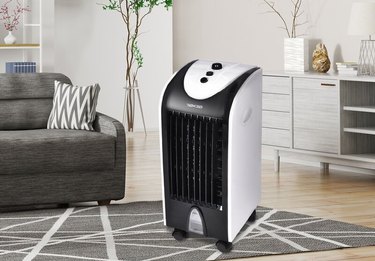When you need to cool a room in your home but don't have the luxury of sacrificing a window, a portable air conditioner may prove a viable solution. Evaporative coolers, also called swamp coolers, are a good way to cool things down without the hassle of installing window units or the expense of adding central air to your home. Depending on where you live, an evaporative cooler will serve you well, but they're not right for every area. It's important to understand the basics of how swamp coolers work so you know if getting one is the right choice.
How They Work
Video of the Day
In a traditional air conditioner, warm air is drawn into the unit and run across a series of metal fins and tubes. Filled with refrigerant, these tubes are ice cold so they can cool the air that blows across them. Evaporative coolers work a little differently.
Video of the Day
Scientists know that when water evaporates, it turns from a liquid into a gas. During this process, warm energy particles break away from the water, leaving behind cool air. This same principle explains why misting yourself with a water bottle makes you feel cooler on a hot day. You're enjoying the coolness left over from the evaporation process. The natural evaporation process is so effective that it can drop the air temperature by as much as 40 degrees Fahrenheit.
Evaporative coolers use this scientific principle to cool the air. Air is drawn into the appliance where a fan blows it over a reservoir filled with water or a pad soaked in water. As the water evaporates, it cools the air around it. Because they lack refrigerant and other chemicals, evaporative coolers are more environmentally friendly than traditional air conditioners. They also use less energy.
Evaporative Cooler Downsides
Evaporative coolers are extremely portable and quite convenient when you don't want to lose a window to an air conditioning vent. There are a few negatives, however. The first is that evaporative coolers do need a bit more maintenance than traditional air conditioners. In order for a swamp cooler to work, you need to make sure the water reservoir or water pad doesn't run dry. You can't just set the thermostat and forget about it as you do with central air.
The bigger issue is that evaporative coolers don't work everywhere. They're excellent in dry climates, but they work poorly in areas of higher humidity. Why? As water evaporates into the air, it increases the humidity, but air can only hold so much water.
Think of the air like a sponge. When it's dry, you can add water to it, and it will gleefully soak it up. When the sponge reaches its maximum saturation point, however, it can't hold any more. At that point, the water will run off the sponge rather than soaking in. The same is true with humid air.
Air can only hold so much water. In areas of high humidity, the air is already saturated. As such, an evaporative cooler can't effectively add water vapor to the air. If the evaporative process can't happen, neither can colder air.
Choosing the Right Evaporative Cooler
Swamp coolers are rated using a measurement called CFM. Standing for cubic feet per minute, the CFM rating measures how much air a swamp cooler can move in one minute. You generally want to look for a unit strong enough to change all of the air in your room 20 to 40 times per hour. Take into account high ceilings and areas of direct sunlight as well as how many people are typically in the room. The more area, sunlight, and people in the room, the more CFMs you'll want.
Some swamp coolers have a hookup that allows you to connect them to a water source. This feature is optional, but it will save you from having to constantly refill the water reservoir. A water level indicator is another handy feature, especially if you plan to refill your cooler manually. Also consider a unit with an oscillating fan that moves cold air from side to side rather than in just one direction.
